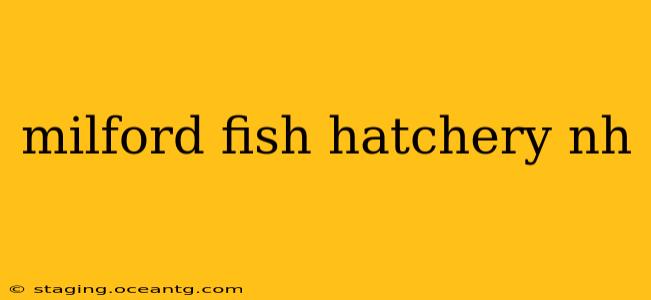New Hampshire's rich natural resources include its abundant waterways, teeming with various fish species. Central to the state's fishing heritage is the Milford Fish Hatchery, a vital facility contributing significantly to the conservation and enhancement of New Hampshire's inland fisheries. This comprehensive guide delves into the hatchery's operations, its role in stocking New Hampshire's lakes and rivers, and answers frequently asked questions about this important resource.
What fish does the Milford Fish Hatchery raise?
The Milford Fish Hatchery primarily raises cold-water species crucial to New Hampshire's fishing economy and recreational opportunities. These include:
- Brook Trout: A native New Hampshire species, brook trout are highly prized for their beauty and fighting spirit, making them a favorite among anglers. The hatchery plays a critical role in maintaining healthy brook trout populations in many of the state's streams and ponds.
- Rainbow Trout: Another popular game fish, rainbow trout are known for their vibrant colors and excellent fight. The hatchery raises significant numbers of rainbows for stocking various waters across the state.
- Landlocked Salmon: These salmon are a highly sought-after species in New Hampshire, and the hatchery contributes to their populations through careful breeding and stocking programs.
What is the role of the Milford Fish Hatchery in stocking New Hampshire waters?
The Milford Fish Hatchery plays a pivotal role in maintaining healthy fish populations in New Hampshire's lakes and rivers. The hatchery raises fish to a suitable size before stocking them in designated waters, ensuring the survival and growth of these fish in their natural environment. This stocking process helps to:
- Enhance recreational fishing opportunities: By providing a regular supply of fish, the hatchery ensures anglers continue to enjoy successful fishing experiences.
- Maintain biodiversity: Stocking helps support the population levels of various species, promoting biodiversity within New Hampshire's aquatic ecosystems.
- Support the economy: Successful fishing attracts tourism, positively impacting local businesses and the state's economy.
How does the Milford Fish Hatchery contribute to conservation efforts?
The Milford Fish Hatchery isn't simply about stocking fish; it's actively involved in conservation. Its work includes:
- Disease prevention and control: Strict protocols are in place to prevent the spread of fish diseases, protecting both the hatchery's stock and wild populations.
- Genetic management: Careful breeding programs help maintain the genetic diversity of fish populations, ensuring their long-term health and resilience.
- Research and development: The hatchery often collaborates with researchers to improve fish rearing techniques and conservation strategies.
Can I visit the Milford Fish Hatchery?
While the Milford Fish Hatchery is not typically open for public tours, the New Hampshire Fish and Game Department often hosts events and educational programs related to fisheries management. It's advisable to check their website for announcements regarding public access and scheduled events.
Where can I find information about fishing regulations in New Hampshire?
For up-to-date information on fishing licenses, regulations, and fishing seasons in New Hampshire, visit the official New Hampshire Fish and Game Department website. They offer a wealth of information to ensure you have a safe and enjoyable fishing experience.
What other hatcheries are there in New Hampshire?
While the Milford Fish Hatchery is a significant facility, New Hampshire has a network of fish hatcheries supporting its fisheries management programs. The specific locations and species raised at other hatcheries will vary, and details can be found on the New Hampshire Fish and Game Department website.
This information provides a comprehensive overview of the Milford Fish Hatchery's crucial role in New Hampshire's ecosystem. Understanding its functions and contributions highlights the importance of responsible fishing practices and the ongoing commitment to preserving New Hampshire's valuable natural resources. Remember to always check the official New Hampshire Fish and Game Department website for the most up-to-date information and regulations.
